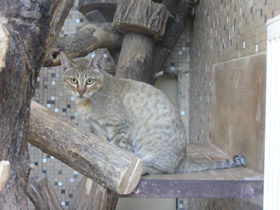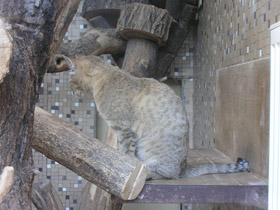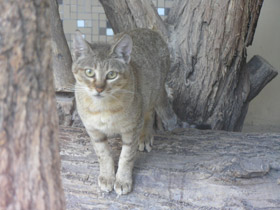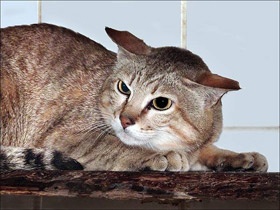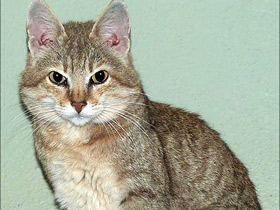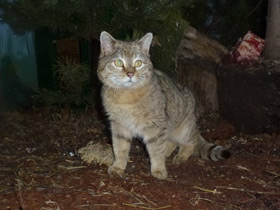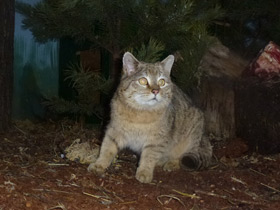The European wildcat (Felis silvestris)
European wildcat видео
 The European wildcat (Felis silvestris caucasica) is included in the Russian Red List
The European wildcat (Felis silvestris caucasica) is included in the Russian Red List
The European wildcat (Felis silvestris) is a small wildcat species native to continental Europe, Scotland, Turkey and the Caucasus.
Appearance
Felis silvestris is a species of wild carnivorous mammal of the Felidae family.
Felis silvestris is brown with black stripes. In summer, its coat is lighter, with less ochre and a less pronounced pattern. Young kittens have shinier velvety black patches with a larger surface area than the main background. There is almost no sex difference in colouring. This species is larger than the domestic cat, with a thick tail as if cupped at the end, its body size from 45 to 80 cm, weight from 3 to 6 kg, height of about 35 cm and tail length of about 30 cm. It has a powerful jaw and long incisors. It has a total of 30 teeth. In all probability, Felis silvestris is the ancestor of all domestic cats; even the set of sounds produced by these animals is identical: purring, meowing, hissing and growling. Except that during the mating season wild individuals are silent and only make noises when they are close to each other.
Habitat
Felis silvestris is found in Europe, northern Asia and Africa. It is a typical inhabitant of broadleaf and mixed forests. The European Felis silvestris used to inhabit the whole of Europe, with the sole exception of the northernmost countries such as Scandinavia and Ireland, as well as some small islands. Today rare populations can be found in Portugal, Scotland, Turkey, the Carpathian Mountains, Sicily and Sardinia. The African subspecies is found throughout the African continent, except in deserts and dense rainforests; the Asian subspecies is distributed from Pakistan and northwest India to Central Asia. The usual habitat of these Felis silvestris is deciduous forest, but they can also live in heathlands, savannahs and swamps.
Behaviour
Felis silvestris are very skittish, often aggressive and tend to move away from human settlements. They are solitary and hunt small mammals and birds, with insects and plants being only a small part of their diet.
Reproduction
Females reach sexual maturity at 9-10 months, males in their third year. During the rutting period, males fight fiercely, accompanied by loud cries. The female's gestation period is 63-68 days. The mother prepares a mink for her kittens before giving birth. The home may be "borrowed" by foxes, porcupines, badgers and even moles. A litter consists of 3 to 5 kittens (one kitten weighs up to 150 g), which are completely defenceless and blind in the first days after birth. At 3 days they begin to crawl, at 10 days they open their eyes and at 20 days they begin to move actively. But it is not until 10-12 weeks later that they begin to hunt as adults. Kittens become independent at 6 months.
Hunting and diet
In Western Europe, the wildcat feeds on hamsters, brown rats, dormice, water voles, voles, and wood mice. From time to time, it also preys on small carnivores like martens, European polecat, stoat, and least weasel (Mustela nivalis), as well as fawns of red deer (Cervus elaphus), roe deer (Capreolus capreolus), and chamois (Rupicapra rupicapra). In the Carpathians, the wildcat feeds primarily on yellow-necked mouse (Apodemus flavicollis), northern red-backed vole (Myodes rutilus), Tatra pine vole (Microtus tatricus), and occasionally also European hare (Lepus europaeus). In Transcarpathia, the wildcat's diet consists of mouse-like rodents, galliformes, and squirrels. In the Dnestr swamps, it preys on Microtus, water voles, and birds, while those living in the Prut swamps primarily target water vole, brown rat, and muskrat (Ondatra zibethicus).
Birds taken by Prut wildcats include warblers, ferruginous duck, Eurasian coot, spotted crake, and gadwall. In Moldavia, the wildcat's winter diet consists primarily of rodents, while it preys on birds, fish, and crayfish in summer. Brown rats and water voles, as well as muskrats and waterfowl are the main sources of food for wildcats in the Kuban River delta. Wildcats in the northern Caucasus feed on mouse-like rodents and edible dormice, as well as birds, young chamois and roe deer on rare occasions. Wildcats on the Black Sea coast are thought to feed on small birds, shrews, and hares. On one occasion, the feathers of a white-tailed eagle and the skull of a kid were found at a den site. In Transcaucasia, the wildcat's diet consists of gerbils, voles, birds, and reptiles in the summer, and birds, mouse-like rodents, and hares in winter.
The Scottish wildcat mainly preys on European rabbit (Oryctolagus cuniculus), field vole (Microtus agrestis), bank vole (Myodes glareolus), wood mouse (Apodemus sylvaticus), and birds.
Taxonomy
Felis (catus) silvestris was the scientific name proposed in 1778 by Johann von Schreber when he described a wild cat based on texts from the early 18th century and before. In the 19th and 20th centuries, several wildcat type specimens were described and proposed as subspecies, including:
- Felis silvestris caucasica proposed by Konstantin Satunin in 1905 was a skin of a female cat collected near Borjomi in Georgia.
- Felis grampia proposed by Gerrit Smith Miller Jr. in 1907 was a skin and a skull of a male wildcat from Invermoriston in Scotland. Miller revised his classification in 1912, proposing Felis silvestris grampia after reviewing more wildcat skins from Scotland.
- Felis tartessia also proposed by Miller in 1907 was a skin and a skull of a male wildcat from Jerez de la Frontera in southern Spain. The wildcats north of the Douro and Ebro Rivers are said to be smaller than in the rest of the region. The disputed "Tartessian" wildcat has kept the same size and proportions as the form that was found in mainland Europe during the Pleistocene Ice Ages.
As of 2017, two subspecies are recognised as valid taxa:
- Felis silvestris silvestris in continental Europe, Scotland and Sicily
- Felis silvestris caucasica in Turkey and the Caucasus.
Zoological specimens of cats that originated on Mediterranean islands are not considered native but introduced, including:
- Felis lybica var sarda proposed in 1885 by Fernand Lataste was a skin and a skull of a male cat from Sarrabus in Sardinia.
- Felis reyi proposed in 1929 by Louis Lavauden who described a skin and a skull of a specimen from Biguglia.
- Felis silvestris cretensis proposed in 1953 by Theodor Haltenorth who described two cat skins that were purchased in a bazaar in Chania.
Threats
In most European countries, European wildcats have become rare. Although legally protected, they are still shot by some people mistaking them for feral cats. In the Scottish Highlands, where approximately 400 were thought to remain in the wild in 2004, interbreeding with feral cats is a significant threat to the wild population's distinctiveness. The population in Portugal and Spain is also threatened by interbreeding with feral cats and loss of habitat. The extent of hybridization is low in Germany, Italy and Luxembourg.
In the 1990s, the easternmost population in Ukraine, Moldova, and the Caucasus was threatened by destruction of broad-leaved forests, entailing a reduction of their range. Only small numbers occur in protected areas.
In captivity
The European wildcat has the reputation for being effectively impossible to raise as a pet. Naturalist Frances Pitt wrote "there was a time when I did not believe this ... my optimism was daunted" by trying to keep a wildcat she named Beelzebina.










